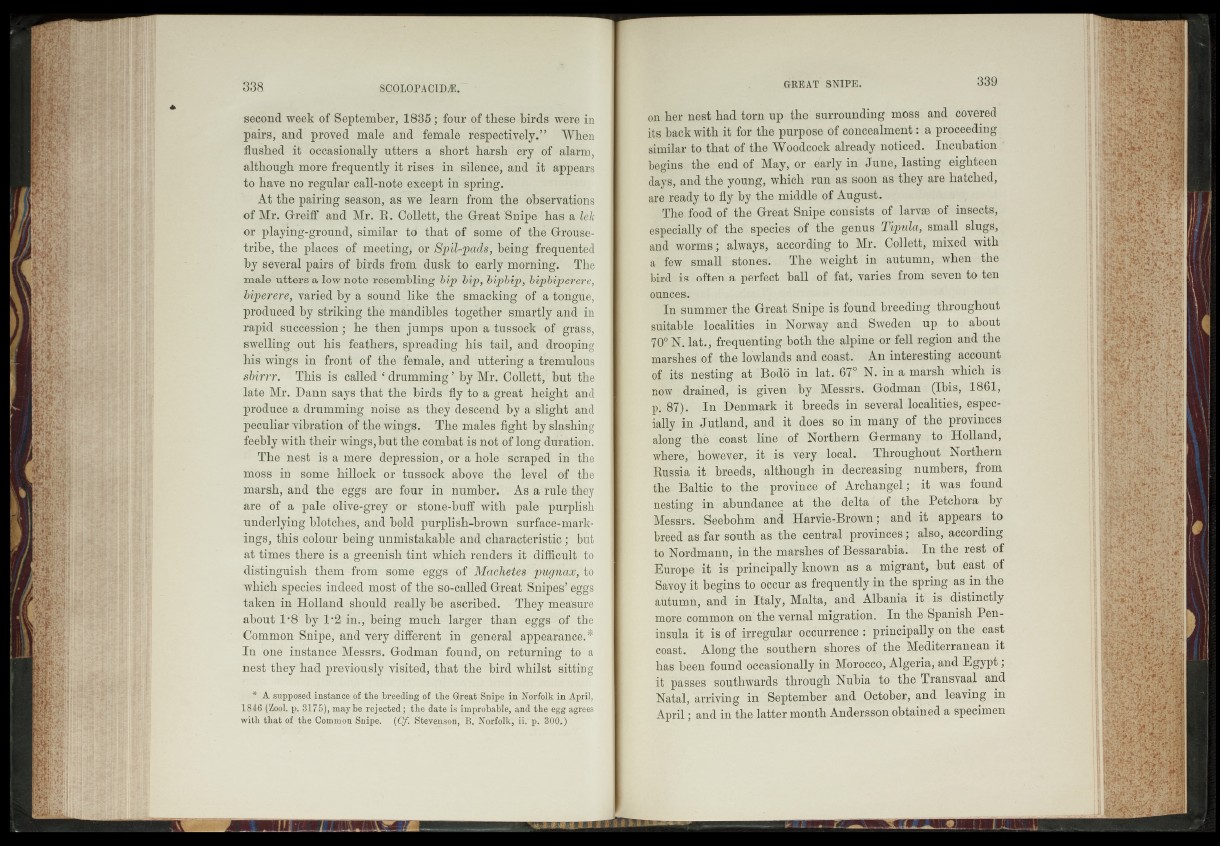
second week of September, 1885 ; four of these birds were in
pairs, and proved male and female respectively.” When
flushed it occasionally utters a short harsh cry of alarm,
although more frequently it rises in silence, and it appears
to have no regular call-note except in spring.
At the pairing season, as we learn from the observations
of Mr. Greiff and Mr. R. Collett, the Great Snipe 'has a lek
or playing-ground, similar to that of sonie of the Grouse-
tribe, the places of meeting^ or Spil-pads, being".frequented
by several pairs of birds frofct dusk to early morning. .-»The
male utters a low note resembling bip bip, bipbip, bipbiperere,
hiper ere, varied by a sound like thé smacking of - a tongue,
produced by striking the mftndibles together smartly "and in
rapid succession; he then jumps upon a tussock of-grass,
swelling oh#his feathers, spreading hCs^âî-1, ahd ^drooping
his wings:?in front of ithé-female, and uttering a tremulous
sbirrr. This is' caïfedP’ drumming ’ by Mr. Cöflêt#/ butrihe
late Mr. Dann says that the birds fly to à great height and
produce a drumming noîsé as, they- descend’ by a slight fand
peculiar vibration of'the wings. The males fight by slashing
feebly with their wings, but the combat ismot of long duration.
The nest "is a mere depression, orsFholg-Sbraped MMhe
nàpss-'ih «some hillock or^tussôcM above the 4^eb- of'-the
marsh, and the-eggs are four in number. As a rule-they
are of a/ paler-'Olive%rey9#r^ ston,e-buff with • pale 'purplish
underlying blotches," *and bold purplish-brown ■ kùrfacë-mark-
ings, this colour being unmistakable and characteristic - but
at times there is a greenish' tin t Which rendfeÿ|:fihf difficult to
"distinguish them r> from sonde " eggsf of" Mackeies* 'piïgnüx, fo'
which species indeed most of, thej so-called Great Sni-pes^ëjggs
taken in Holland should rjs^lyTbe ascribed." ■ Thè’yuliea'sure
about 1:8 by 1-2" in.-, being- much'larger, than' 'uggs,;?o#: the
Common Snipef antf^very different in general* appearance?*
In ené instance Messrs. Godman - fë^fidp on returning to a
nest they' had previously visited, that the bird whilst I sitting
* A supposed instance of the breeding of jjhe Grea#SjojJ>e, jn EojjfpJJs in April,
18,46 ï>. may be?'r,ejected^ the d§,te; is imrorqbatile, and;the egg agrees
with that of the Coïûnfpii Snipe.' \ y f .'SteVéniorijrB.*N6Ao]hi,ifi^p^pWo?)
on her nest had torn up the surrounding moss and covered
it# back with it for the purpose of concealment: I a proceeding jf
similar to that of the Woodcock already noticed. Incubation '
begins the end of May, nr early in June, lasting eighteen
days, and the young, which' run as soon, as they are hatched,
are ready to fly bp. the. middle of August,
The, food of the Great Snipe consists „of larvae of insects,
especially of the. - species of the genus Tipula, small slugs,
and worms; always, according to Mr. Collett, mixed with
a few small'.stones’.. The weight "in autumn/-when, the
bird is often "a perfect ball of fat, varies from seven to ten
ounces.
In -summer the Great Snipe .is found breeding throughout
suitable- -localities - in-. Norway rand , Sweden up to about
7Q?;N. lat.,|frequenting.both the alpinacbnlejl region .and the
marshes' of ,th'e lowlands and .coast.- An interesting account
ot.its nesting. -aU Bode in> l a t Nc r i n a marsh which .is
now - drained,-.isifcgiven by Messrs. Godman 1 (Ibis, 1861,
p.^,7 ). In Denmark-at breeds in severaljlocalities, especr
ially.in Jutland, and it does so,in many, of£the provinces
along "the .coast;'line.'of Northern Germany to Holland,
whdre/ however, i.tt'is %very .local; ThroughoutrNorthern
Russia -it:- breeds, -.although in decreasing numbers, from
the- Baltici to,-the i province of Archangeli^/it was found
noting in abundance at jthp^idgitaiWif the , Petcb.qra,.,b.y
Messrs.•'•Seebohm' and Harvie-Browh; and it appears ■ to
breed as far south' as the central provinces; also, according
to Nordmann, in'the-marshes of Bessarabia.'* Jmthe rest of
Europe -it; ,is.*pirincipally known ,.as > a Emigrant, ;bnt east of
Savoy it, begins; tmoceui’,' as frequently in - the .spring-as in the
autumn,and in Italy, Malta, and Albania -itfris distinctly
more common on-the vernal migration. In "the-Spanish Pen-;
insula it is .of irregnlar occurrence : principally on. the east
coast. Along the south?1;11 ;#horep o|,;tbe Me<literr anean it
has been found occasionally-inMoroeoq, Algeria, and Egypt;
'wfp’aises southwards through Nubia un the Transvaal and
Natal, arriving in September and?,Octtober, and leaving in
April; and in the latter month Andersson obtained a specimen